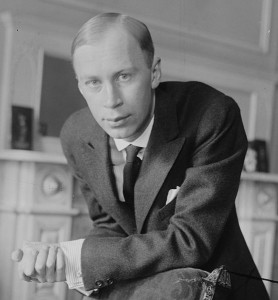Prokofiev: Violin Concerto No. 2 (2d movement)
 Since we focused on Sibelius last week while traveling between Helsinki and St. Petersburg, it seems fitting to focus this week on a Russian composer. Sergei Prokofiev (1891-1953) certainly fills the bill as Russian, but he is not the Russian version of the nationalist Sibelius. Prokofiev left Russia in 1918, shortly after the Revolution, and had a rather difficult time after resettling in Russia in 1935.
Since we focused on Sibelius last week while traveling between Helsinki and St. Petersburg, it seems fitting to focus this week on a Russian composer. Sergei Prokofiev (1891-1953) certainly fills the bill as Russian, but he is not the Russian version of the nationalist Sibelius. Prokofiev left Russia in 1918, shortly after the Revolution, and had a rather difficult time after resettling in Russia in 1935.
If you know nothing else of Prokofiev, you probably know his Peter and the Wolf (1936), the inventive children’s tale for narrator and orchestra.
Prokofiev’s music, like that of many late Romantic Russian composers, is full of color and energy. It can be quite angular and dissonant, but he was a master melodist. And, in contrast to some of the excesses of the post-World War I era, he subscribed to a “new simplicity.” An excellent example of that simplicity can be heard in the middle movement of his Violin Concerto No. 2, a simple diatonic melody over a sparse pizzicato accompaniment.
Stalin’s tastes ran in other directions. Eight of Prokofiev’s works were banned by “Zhdanov Decree.”
In early 1948, following a meeting of Soviet composers convened by Andrei Zhdanov, the Politburo issued a resolution denouncing Prokofiev, Dmitri Shostakovich, Myaskovsky, and Khachaturian of the crime of “formalism”, described as a “renunciation of the basic principles of classical music” in favour of “muddled, nerve-racking” sounds that “turned music into cacophony”.
Obviously, the Soviets got many things wrong. But in the wake of the ban, performances of Prokofiev’s works were cancelled. Prokofiev fell into ill health a year later. He died on the same day as Stalin.



